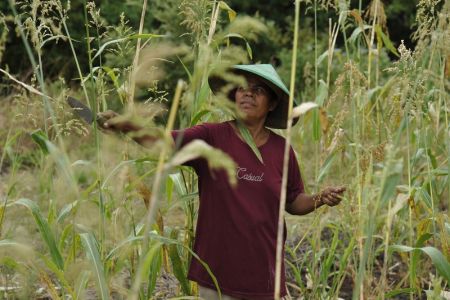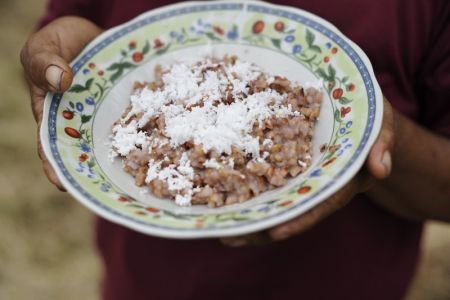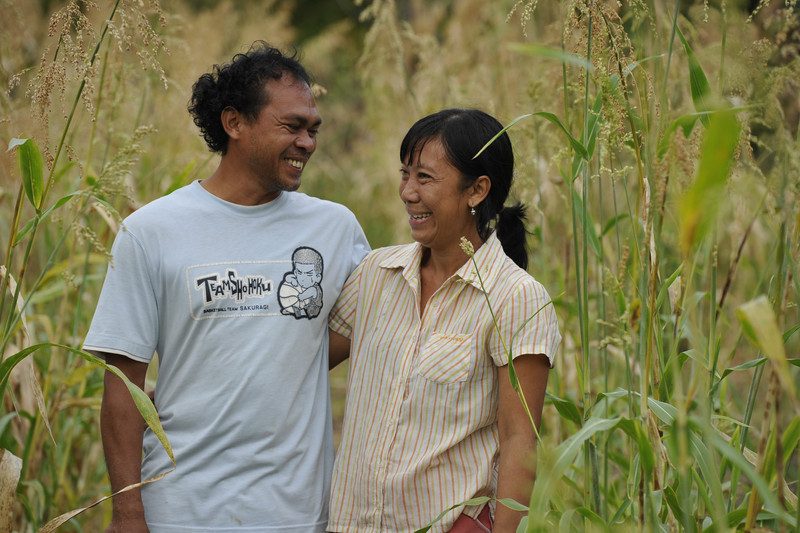In part one of her interview, we learned of Maria Loretha’s brave move from city life to a no-frills rural existence which involved living off the land and adapting her crops to cope with climate change.
While other farmers on her island initially wrote her off as crazy for cutting down many of her cashew and coconut trees and replacing them with hardy sorghum crops, they soon came around to her way of thinking.
Now Maria Loretha is leading a sorghum revolution throughout the province of Nusa Tenggara Timur. When she’s not on her farm, she’s travelling to local farming groups to spread the word about sorghum.
Interview by Lara McKinley
Love at first taste
Why did you start planting sorghum on your farm?
I fell in love with sorghum when my neighbour Maria Helen gave to me a plate of steamed sorghum with coconut flakes …
Maria Helen didn’t have any seeds, but said her sister had some. In fact, it was not easy to find sorghum seeds. They said they were in a neighbouring village, but when I went there, there were no seeds. Others talked to me about the seeds existing in another sub-district but again … I couldn’t find them.
Finally I hunted the seeds of sorghum, so I could grow it and offer the seeds to others who wanted to grow it. Elders in the village who are older than 40 know sorghum, but people below 40 don’t know sorghum exists.
It is not only ordinary people who don’t know about it: even people in agricultural production don’t know … because since the late 1970s the government has been campaigning that people should eat rice … It’s why people automatically don’t eat corn, sorghum or millet.
When the government campaigned about rice, they gave not only the seeds but also the fertilizer, pesticides. That’s why finally rice could be accepted by all people as the main staple. And that meant other foods were abandoned.

And when your neighbours realized you weren’t crazy for planting sorghum, how did things improve?
Well, after the failure of the harvest for cashew nuts, some farmers who were aware of the need to grow sorghum came to the farm for the seeds and to ask how to grow it.
I … gave them the seeds on the condition that they planted them to eat and not give to their animals.
Those who don’t have land to farm, can grow it here. The condition is they have to cut down some more of my cashew trees, so we can use the land to plant sorghum.
“Sorghum is the answer”
What are the benefits of sorghum?
Sorghum is fit for the island in NTT, and the rest of Flores. Sorghum can adapt to the changing climate: even when the dry season keeps going, or there is a long rainy season, sorghum still grows.
Even if there’s a storm and the sorghum plants fall to the ground, they grow back. When the rain pours heavily, it grows. When the sun blazes very hot, it grows stronger.
Sorghum is the answer for hunger in this area because sorghum can grow in this land. The land is very dry. Rice and corn need water and fertilizer, but not sorghum … Since sorghum is adaptable to dry, harsh land it’s the answer for people who are facing food insecurity.
Based on my experience with other farmers we also know that when we do eat sorghum, we feel fuller for longer than with rice.
What do you think the main problem is with food insecurity in NTT?
Outsiders think people in Flores live in poverty but I don’t think that’s correct. We don’t live in a difficult situation in terms of food. There are many choices of food: bisang (bananas), budi (sweet potato) and sorghum.
I feel like I live an extraordinary life while I live in Flores. If it’s not me, then who would understand about the life of a farmer? I understand, because I am a farmer.
If it’s not me, then who will look after the other farmers? People tend to say there is food insecurity in NTT. People from the government and NGOs and the media keep exposing food insecurity but they have no answer. I say, sorghum is the answer.
Sorghum is the answer, because who will solve the problem of food insecurity if not us farmers?
How many times a year do you harvest sorghum?
Sorghum harvests three times a year. Rice you can harvest rice once a year in the wet season.
How versatile is sorghum for cooking?
It’s easy to provide meals from sorghum. We can cook it as porridge, or make sorghum as a flour, and then the flour can be cooked into brownies, pizza and varieties of cookies [or] as pop-sorghum like pop corn.

Of happiness and harvesting
Can you describe what happened this morning?
I was really happy this morning. I came to the farm to see my sorghum and I was happy when I saw them, ripe and ready to be harvested. I sang a song because I was happy that I would have enough food to eat. I know I carry enough seeds to give to other farmers.
This morning a friend from my farming group came to us. It was time to harvest the crop. They were also happy because they will get their own part of the harvest.
My friends say I am the maestro of sorghum, a master sorghum grower, but I am just an ordinary farmer. So far, it’s only small-scale sorghum planting. We need the sorghum we plant, for food and for seeds.




